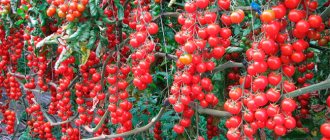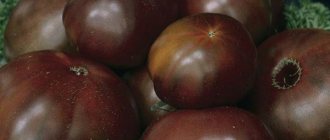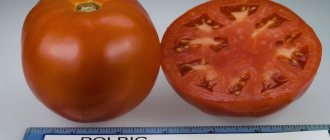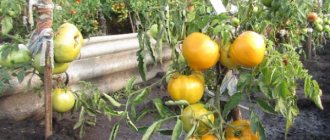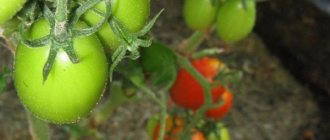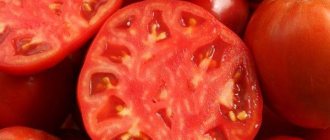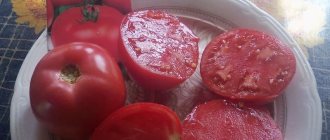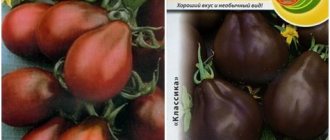Description of the variety
The Raspberry Giant variety was bred by Russian breeders. The patent holder is agro. The authors are recognized as A. N. Lukyanenko, S. V. Dubinin, I. N. Dubinina. The variety was included in the State Register in 2007. This chic tomato is intended for growing both in open ground and under film covers.
The variety is declared as early ripening, tall, determinate, and does not require pinching. It reaches a height of 90 centimeters. The stem is powerful, the foliage is dense, the rhizome is well developed.
The fruits are truly gigantic: reaching 200-400 grams. During the season, 6 kilograms of such fruits are collected from one plant. Tomatoes have a slightly flattened shape and are pink in color. The skin is dense, so the fruits retain their presentation for a long time and do not crack even during transportation. They have few seeds. Giants are good not only in the photo - the taste is also excellent. The pulp of the fruit is juicy, tastes sweet and sour.
Fruit characteristics
- The fruits of the Raspberry Giant tomato variety weigh differently. Usually, tomatoes up to 400 g grow at the bottom of the bush; smaller tomatoes form on the upper branches.
- The shape is round, well flattened at the stalk and tip. There is slight ribbing. Often tomatoes of this variety have the correct shape.
- Do not crack.
- Inside there are 4 or more seed chambers containing few seeds.
- The skin is thin and dense.
- Ripe tomatoes pink or raspberry color.
- The pulp is fleshy, juicy, medium density.
Important! Tomato seeds are small, like most large-fruited varieties.
- The concentration of dry matter is below average.
- Tomatoes have good keeping quality.
- Resistant to long-distance transportation.
- The taste of the tomato is sweet with a slight sourness.
- They do not cause allergies, so they can be included in dietary and baby food.
Interesting! Pink tomatoes contain more nutrients than red ones.
We grow seedlings
Tomatoes are grown in seedlings and without seedlings. It all depends on the climate in which they will grow. But even when grown in the southern region, where the climate allows tomatoes to be planted directly in the ground, growing through seedlings speeds up the ripening time of fruits and increases productivity.
Seed preparation
Tomato seeds are sown after March 10. Before this, they need to be checked for germination and prepared for planting.
Reference. When choosing seeds, you may encounter first-generation hybrids Raspberry giant F1. Know: the Raspberry Giant does not have any hybrids , this is just a marketing ploy! Both in the package of the “parent” variety and in the package of the F1 hybrid, the seeds are absolutely identical. Manufacturers are simply trying to attract attention to already known varieties, allegedly improving them through hybridization.
We check for germination like this: put all the seeds in a glass of water and wait 20 minutes. We only need those seeds that fell to the bottom. If the seed does not sink, it means that it was poorly preserved and it will not produce a healthy plant.
After checking for germination, you can soak the seeds in a growth stimulator. This will increase the germination rate.
Soil and planting container
The soil must be nutritious. A substrate made of soil, sand and peat is perfect. To reduce acidity, ash is added to the soil. If you don’t want to create a suitable substrate yourself, buy a ready-made one. Choose special soil for seedlings.
Any container for planting is suitable - from a plastic container to a peat pot. The main thing is to make drainage holes at the bottom.
Sowing and cultivation
Let's start sowing. We will plant in a common container.
Usually, to moisten the soil when sowing, it is sprayed with warm water, but we will tell you about another method. After covering the seeds with soil, fill the container to the brim with snow.
This method is good because, in addition to moistening the soil with melt water, which has long been called “living”, we carry out mini-stratification. This increases germination and accelerates seed germination. If you no longer have snow, use melt water.
How to plant seeds:
- Lightly compact the soil. The container should be half filled.
- We make grooves about 2 centimeters deep. Leave the distance between the grooves 2-4 centimeters.
- Place the seeds at the bottom of the grooves. The distance between seeds is 2-4 centimeters.
- Sprinkle the seeds with soil.
- We moisten the soil.
- Cover the container with a transparent lid or film and place in a warm, bright place.
- Once a day, be sure to ventilate the greenhouse and remove condensation from the lid.
- As soon as friendly shoots appear, we open the seedlings.
- Water as the soil dries. It is important not to overdry, but also not to over-moisten.
- To prevent the seedlings from stretching, we provide illumination.
- When the plants have two true leaves, we plant them in separate pots.
- We continue to care for the seedlings and wait for the right time to plant them in open ground.
Features of planting and care
To grow the Raspberry Giant tomato variety, you need to buy seeds from trusted seed producers. The tomato is not a hybrid. If the variety is already growing in the yard, you can collect the seeds yourself from overripe fruits.
It is better to grow tomatoes as seedlings. Sowing time depends on the climate of the region, but most often the work occurs at the end of February - beginning of March. Before sowing, the seeds of the Raspberry Giant are treated:
- The first step is calibration. Tomato grains are sorted by hand and damaged specimens are discarded. Pour 1 tbsp into a jar with 1 liter of water. l. salt, immerse the seeds. The floating grains are discarded, and those that have settled to the bottom are used for further preparation.
- After calibration, the tomato seeds are placed in a pink solution of potassium permanganate for 30 minutes for disinfection.
- The last stage of preparation is awakening the seeds. Tomato grains are soaked in aloe flower juice or any store-bought stimulant, for example Zircon.
You can germinate the seeds of the Raspberry Giant at the discretion of the gardener, but the hatched grains will sprout earlier.
Advice! The optimal time for seed preparation and the beginning of sowing can be found out from the lunar calendar.
At the time of completion of the preparation of the Raspberry Giant tomato seeds, the container for planting and the substrate must be prepared. The soil is bought in a store or collected from the garden. In the second case, prepare a soil mixture with the addition of an equal part of humus. Add a glass of ash, a third of the volume of sand, and a mineral complex according to the instructions to the bucket of the mixture. At least three days before sowing, the soil mixture is disinfected with boiling water with the addition of manganese.
Raspberry Giant grains are sown in depressions of approximately 5 mm. The seeds are placed 2 cm apart from each other. Sprinkle the top of the tomato grains with soil and moisten them with a spray bottle. The container is placed on the windowsill, covered with film, and awaits germination.
When the Raspberry Giant tomatoes grow and throw out three true leaves, the plants are picked. Tomatoes are transplanted into separate cups, where they will grow until planted in a permanent place.
Many reviews recommend dipping the Raspberry Giant tomato into peat cups. When planting in a permanent place, the plant is immersed in the hole along with the container. The method reduces the likelihood of root damage, which often occurs when removing seedlings from a plastic cup.
After picking, the tomatoes are given a couple of days of calm to take root. At this time, the seedlings of the Raspberry Giant variety are shaded from the sun in the window. Further care for tomatoes includes timely watering and additional lighting. 14 days after picking, the tomatoes are fed with nitrogen-containing fertilizer, which stimulates the growth of green mass. 2 weeks before planting, young tomatoes of the Raspberry Gigant variety are hardened by taking them outside.
When growing varieties in greenhouses, seedlings are planted in a permanent place from mid-April. Landing on the street is carried out in late May or early June.
1-2 weeks before planting the Crimson Giant seedlings, prepare the bed:
- the ground is dug up using a shovel, the roots of the grass are removed;
- Using a watering can, water the bed with boiling water and manganese.
On the day of planting, holes are dug in the area up to 40 cm deep. A distance of at least 50 cm is maintained between the holes. It is optimal to arrange the holes in rows in a checkerboard pattern. A little sand, humus and superphosphate are added to the hole according to the instructions. Water each hole with warm water and plant tomatoes. Ash can be scattered on top of the bed. Organic matter will act as fertilizer and protect young tomatoes from pests.
Immediately after planting Raspberry Giant tomatoes, the plants are given complete rest. Tomatoes are only shaded from the sun, watered, and weeds are removed. After two weeks, the tomatoes should take root and become stronger. Plants at this stage are fed with mineral complexes. Fertilizers are applied simultaneously with watering. After the liquid is absorbed, the soil is loosened to prevent the formation of a crust.
2 weeks after the first procedure, the Raspberry Giant variety needs organic matter. Tomatoes are topped with a solution of bird droppings in a consistency of 1:20. You can use manure by dissolving it in water at a ratio of 1:12. Subsequent feeding of tomatoes is carried out after 3 weeks, alternating organic matter and mineral complexes.
Advice! The Raspberry Giant variety responds well to foliar feeding. Tomatoes are sprayed in the morning or evening in dry weather.
As the tomatoes grow, they are tied to a support, which can be an ordinary wooden peg. To increase productivity, tomatoes are formed into 2 stems. The plant is left with a main trunk and one stepson in the upper axil. The lower tier of foliage is torn off for better ventilation under the bushes.
Important! Stepchildren on tomatoes break off in the evening not in hot weather. At the time of the procedure, the shoots should grow up to 10 cm long.
The crimson Giant variety rarely needs the use of pesticides. For prevention, it is enough to spray the plantings with a weak solution of potassium permanganate once a week. Insect pests can be repelled with infusions of herbs, hot spices, and tansy.
Planting in open ground
When the threat of return frosts has passed, you can plant the seedlings in open ground:
- We plant seedlings in holes at a distance of at least 50 centimeters from each other. When planting, you can add fertilizer to the holes. The most suitable one is phosphorus-containing.
- The crimson giant definitely requires a garter. Take this into account when landing.
- We water our giants as needed, trying not to get it on the foliage. Water for irrigation must be warm (cold water causes plants to stop growing and the roots may rot). For convenience, you can organize drip irrigation.
- Plants need to be fed several times a season. Feeding stops 3-4 weeks before fruit ripening.
- Plants require partial pinching. A good solution would be to form bushes into two stems. Remove all lower leaves up to the first ovary.
- We tie the formed bushes with ropes made of cotton fabric 10-15 centimeters wide. Thin threads or stiff wire are not suitable - they injure the stem.
- We periodically loosen the soil to saturate it with oxygen. The heavier the soil, the deeper we loosen it. We do this carefully so as not to damage the roots of the plant.
Features of cultivation
In general, the Raspberry Giant tomato is no different in care from other determinate varieties. However, difficulties may arise due to the large weight of the fruit. The bush may simply not withstand the weight and break. Therefore, be sure to tie up the tomatoes. In order for the tomatoes to ripen well and the harvest to please you, you need to leave no more than five fruits on the bush.
Growing in open ground
The raspberry giant feels great in a greenhouse, but outside a greenhouse, experienced gardeners advise growing it only in warm climates. If you do not have such conditions, at least provide the bushes with temporary shelter in case of bad weather.
Description of the Raspberry Giant tomato
A review of the Raspberry Giant tomato, characteristics and description of the variety should begin with the fact that the crop has a hybrid of the same name. Its brother “Crimson Giant F1” has better characteristics. The varietal crop is slightly inferior in size and taste of the fruit, and in its tolerance to poor conditions.
The variety belongs to the determinate group of tomatoes. The bushes are not standard, but they do without the mandatory procedure of pinching the top. The root of the tomato is powerful, grows strongly on the sides, but does not go deep. The foliage shape is classic, like all tomatoes. The leaf blade is dark green. There are faint wrinkles on the surface of the leaf; there is no edge. The tomato bush is growing large. The stems are thick, strong, densely covered with foliage. Depending on the growing conditions, the height of the plant varies from 0.5 to 1 m. The average height of a tomato is 0.7 m.
The Raspberry Giant tomato bush forms simple inflorescences. It can grow up to 8 flowers, but they are not removed. According to the timing of the harvest, the variety is considered early. The fruits are borne in fan-type clusters. Up to 12 of them can form on one bush. The fruits practically do not crack and are firmly held on the stalk.
The video provides an overview of the Crimson Giant:
Description of fruits
Reviews and photos about the Raspberry Giant tomato confirm that the variety is large-fruited. The amount of clusters formed depends on the method of forming the bush: 1 or 2 stems. The fruits grow in a round, flattened shape. There is slight ribbing on the walls of the stalk. Each cluster produces tomatoes of approximately the same size. On average, the fruit weighs 200-400 g.
Important! You can grow larger fruits weighing up to 500 g, but to do this you will have to adjust the number of flowers and increase fertilizing.
The skin of the fruit is thin but durable. The surface is shiny. The greens begin with a characteristic dark area near the stalk. When fully ripe, the tomato acquires a beautiful crimson color. The pulp is fleshy, moderately juicy. A tomato contains 4-8 seed chambers. The grains are small, there are few of them in the chambers. The taste of a ripe tomato is sweetish with a pleasant feeling of mild acidity.
Diseases and pests
Breeders claim that the variety is resistant to all diseases, especially blossom end rot. However, reviews of the variety often mention that late blight and cladosporiosis are dangerous for plants in the same way as for other varieties of tomatoes.
And although the tomato has good immunity to diseases, it can be threatened by pests. To prevent thrips, aphids, spider mites or Colorado potato beetles from reaching your bushes, spray them with general pest control products for prevention.
Advantages and disadvantages
Gardeners love the crimson giant for:
- large fruits;
- precocity;
- good transportability and presentation;
- immunity to many diseases;
- relative ease of care;
- Possibility of use both fresh and prepared;
- a large number of useful substances and hypoallergenic.
However, the variety also has disadvantages:
- it is difficult to preserve whole tomatoes for the winter;
- large rhizomes take up a lot of space;
- although special care is not required, it is necessary to shape and plant the bush;
- Despite the declared resistance to almost all diseases, the most common of them can still affect the plant.
Reviews
In general, reviews about the variety are positive. Some summer residents note that official information about tomatoes differs from the real one. For example, a variety declared as early ripening, in terms of ripening time, is more suitable for the characteristics of mid-ripening.
Lyubov Salmanova, Novosibirsk: “The raspberry giant – I really, really liked the taste: sweet, meaty. Raised by an employee. Seeing my unhealthy passion for tomatoes, she brought me one for seeds. It is growing in a greenhouse and is now bearing fruit safely. The yield is high: the fruits are large and there are a lot of them. What’s surprising: I don’t tie up my brushes, and nothing breaks.”
Nadezhda Pavlova, Volgograd: “My Crimson Giant was very tall, in open ground it grew to almost three meters in height. Fruited from June to October. Tasty, sweet with sourness, not bland. I will definitely repeat it."
Polina Arslanova, Nizhny Novgorod region: “I have this amateur variety, and there is a difference with the description. The tomato is indeterminate and has an average ripening period. The fruits are large and do not subsequently become smaller. I noticed that it’s better to grow in 1-2 stems.”
Advantages and disadvantages
This variety is extremely popular; it can be argued that it has many more advantages than disadvantages.
Positive characteristics:
- due to the large amount of dry matter, the fruits are well preserved (but only in the right conditions);
- early variety - the first harvest appears 90-100 days after sowing;
- because it is a hybrid (as evidenced by the F1 sign), it is self-pollinating;
- not picky about growing conditions and weather changes;
- resistant to the main diseases of the nightshade group (phytophthora, powdery rot, Alternaria, Fusarium, Verticillium) and various types of fungus);
- high productivity;
- excellent taste.
():
All tomato varieties without exception cross-pollinate (self-pollinate), and the F1 sign indicates that this is a first-generation hybrid, so its seeds are not suitable for re-sowing.
The Crimson Giant also has some shortcomings in its description.
- Large fruits often have skin that cracks, which reduces their marketability significantly.
- The appearance is often spoiled by an irregular shape (distorted roundness).
- The variety loves fertilizers and, if there is not enough of them, the base of the stalk becomes hard and has a yellow or light green color.
- It will not be possible to collect the seeds yourself at home, because... they will be unsuitable for sowing.
